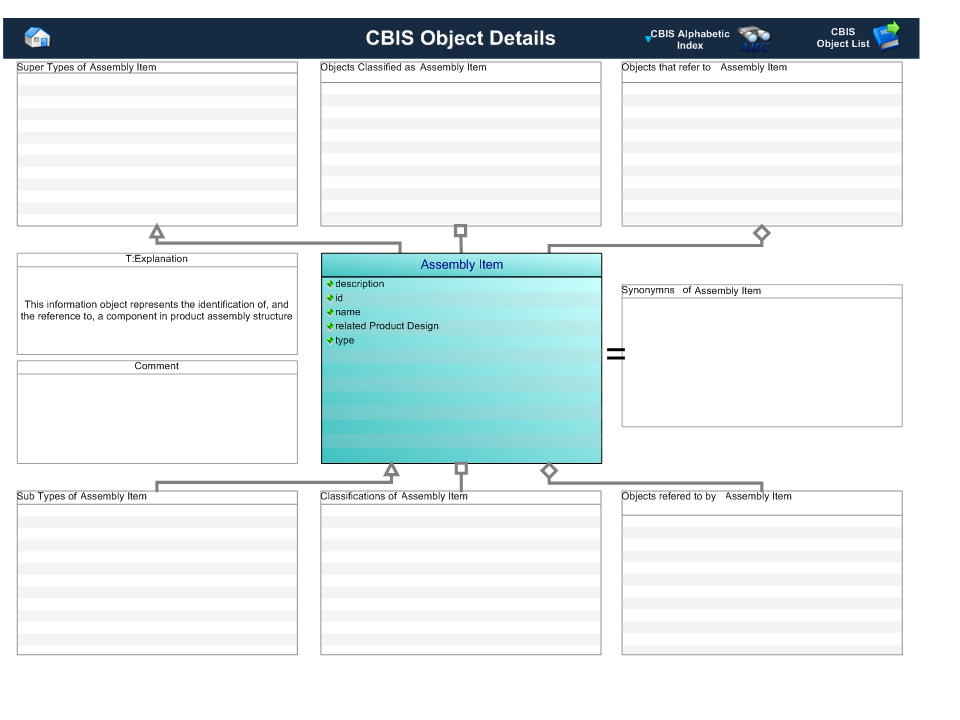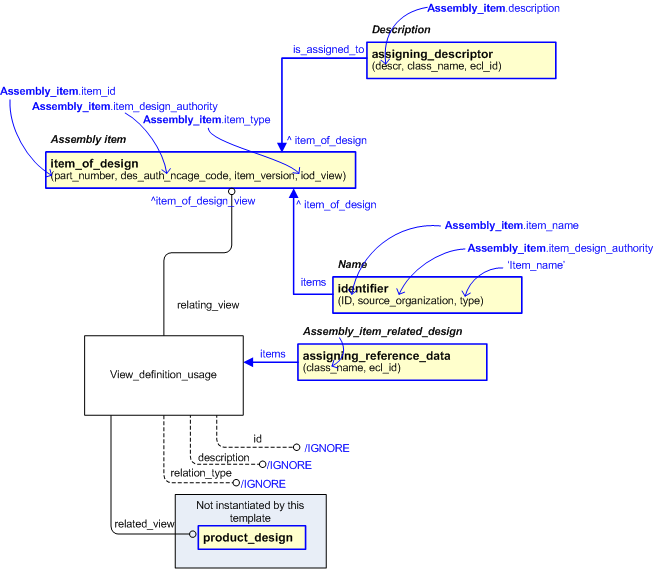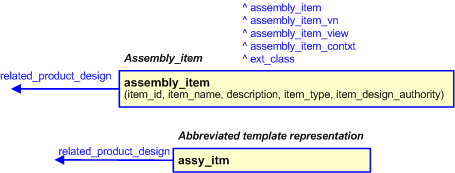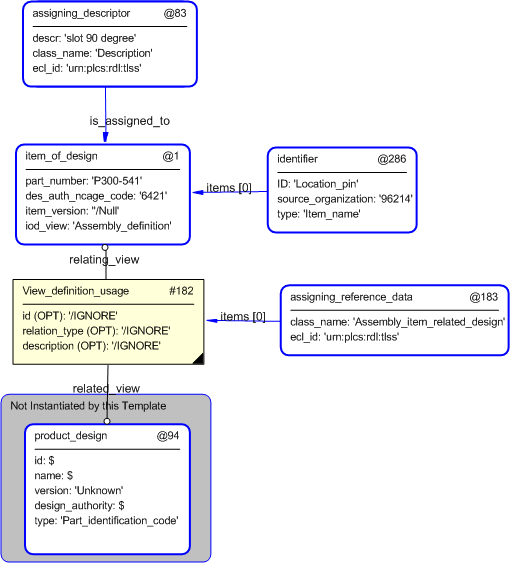Template:— assembly_item (assy_itm)
Context:— UK_Defence |
Date: 2009/04/17 10:13:45
Revision: 1.2
|
This section specifies the template assembly_item.
NOTE
The template has been defined in the context of
UK_Defence.
Refer to the business context for details of related templates.
NOTE
An explanation of a template and the associated instantiation path is
provided in the
Template overview
section.
This template describes how to represent the UK_Defence concept of a assembly item
in terms of PLCS model elements (templates, entities, and reference data).
This template describes how to represent the identification of, and the reference to, a component in product assembly structure.
Figure 1 — Graphical Representation for Business Object Assembly Item attribute details
This information object represents the information for an assembly item.
|
Attribute name
|
Attribute description
|
Attribute type
|
Optionality
|
| description |
This attribute provides a description of the Assembly Item. |
Intrinsic |
Mandatory |
| id |
This attribute provides an identifier associated with the assembly item. |
Identifier |
Mandatory |
| name |
This attribute provides the name of the Assembly Item being used. |
Intrinsic |
Mandatory |
| related Product Design |
This identifies any related product design information. |
Intrinsic |
Mandatory |
| type |
This attribute provides the type of assembly item being provided.
For example, the assembly item may provide an assembly definition or manufacturing definition, or other subclassification
of these.
|
Intrinsic |
Mandatory |
Table 1 — Assembly Item attribute details
The EXPRESS-G diagram in
Figure
2
shows the templates and EXPRESS entities that are required
to represent the template
"assembly_item".
The text highlighted in blue shows the template parameters.
Figure 2 — An EXPRESS-G representation of the Information model for assembly_item
The graphic for the template to be used in other EXPRESS-G diagrams
is shown in Figure
3
below.
Figure 3 — The graphical representation of the assembly_item template
The following input parameters are defined for this template:
The item id (part number)
The description of the document.
item_type (Default=Assembly_definition,Type='CLASS')
The following classes and their sub-classes can be used:
classifications: [Manufacturing_definition]![[warning:]](../../../../../../images/dex/warning.gif) Error RDL4: The URI urn:plcs:rdl:uk_defence is not listed in dexlib/data/refdata/rdl_index.xml[Assembly_definition]
Error RDL4: The URI urn:plcs:rdl:uk_defence is not listed in dexlib/data/refdata/rdl_index.xml[Assembly_definition]![[warning:]](../../../../../../images/dex/warning.gif) Error RDL4: The URI urn:plcs:rdl:uk_defence is not listed in dexlib/data/refdata/rdl_index.xml
Error RDL4: The URI urn:plcs:rdl:uk_defence is not listed in dexlib/data/refdata/rdl_index.xml
The ncage identifier of the design authority that provides the part number
Relates a view of the Product Design a view of another Product Design.
The related component of the Product Design business object is expressed as a
Product_view_definition.
The following reference parameters are defined for this template:
Allow the
Part
entity instantiated in this path to be referenced when this template is used.
Note: The
Part
entity can be referenced in a template path by:
%^target = $assembly_item.assembly_item%
where
target
is the parameter to which the
Part
is bound.
Allow the
Part_version
entity instantiated in this path to be referenced when this template is used.
Note: The
Part_version
entity can be referenced in a template path by:
%^target = $assembly_item.assembly_item_vn%
where
target
is the parameter to which the
Part_version
is bound.
Allow the
Part_view_definition
entity instantiated in this path to be referenced when this template is used.
%^target = $assembly_item.assembly_item_view%
%^target = $assembly_item.assembly_item_cntxt%
Allow the
External_class
entity instantiated in this path to be referenced when this template is used.
Note: The
External_class
entity can be referenced in a template path by:
%^target = $assembly_item.ext_class%
The instantiation path shown below specifies the entities that are to be
instantiated by the template.
A description of templates and the syntax for the instantiation path is
provided in the
Templates Help/Information section.
/
item_of_design(
part_number=@item_id,
des_auth_ncage_code=@item_design_authority,
item_version='/Null',
iod_view=@item_type)/
%^assembly_item = $item_of_design.item_of_design%
%^assembly_item_vn = $item_of_design.item_of_design_version%
%^assembly_item_view = $item_of_design.item_of_design_view%
%^assembly_item_cntxt = $item_of_design.item_of_design_contxt%
-- The assembly item id is applied to the IOD above - hence this assignment is unecessary -- /identifier(items=^assembly_item, ID=@item_id, type='Part_identification_code', source_organization=@item_design_authority)/
/
identifier(
items=^assembly_item,
ID=@item_name,
type='Item_name',
source_organization=@item_design_authority)/
-- description /
assigning_descriptor(
descr=@description,
class_name='Description',
ecl_id='urn:plcs:rdl:uk_defence',
is_assigned_to=^assembly_item)/
View_definition_usageView_definition_usage.id = '/IGNORE'
View_definition_usage.description = '/IGNORE'
View_definition_usage.relation_type = '/IGNORE'
View_definition_usage.relating_view ->
^assembly_item
View_definition_usage.related_view ->
@related_product_design/
assigning_reference_data(
items=View_definition_usage,
class_name='Assembly_item_related_design',
ecl_id=urn:plcs:rdl:uk_defence)/
The following entities are instantiated with attributes as specified:
The instance diagram in Figure
4
shows an example of the EXPRESS entities and templates that are instantiated by the template:
/assembly_item(item_id='P300-541', item_name='Location pin', description='slot 90 degree', item_type='Assembly_definition', item_design_authority='96412', related_product_design='@100')/
(an illustration of the consolidated assembly_item template is shown in
Figure
5 below.)
Figure 4 — Entities instantiated by assembly_item template
The instance diagram in
Figure
5
shows the graphic symbol for the template that is to be
used in other instance diagrams. The example template is:
/assembly_item(item_id='P300-541', item_name='Location pin', description='slot 90 degree', item_type='Assembly_definition', item_design_authority='96412', related_product_design='@100')/
Figure 5 — Instantiation of assembly_item template
Characterizations
No common characterizations of the template
assembly_item
have been identified. However, the ISO 10303-239 EXPRESS model
may enable other assignments to the entities instantiated by the template.




